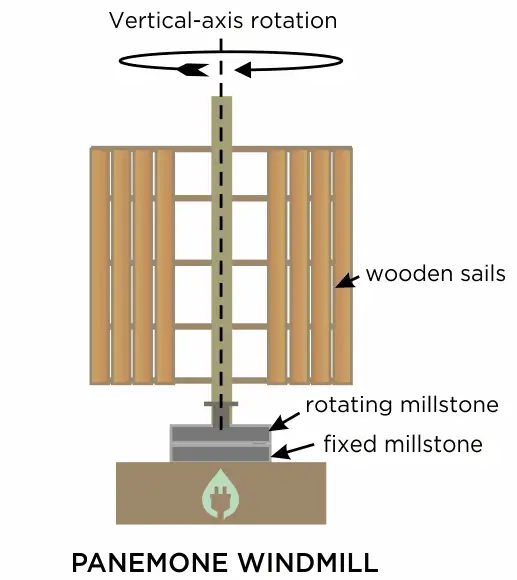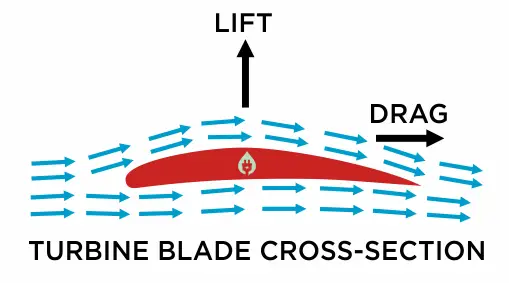Wind Energy simply means using the power of the wind to drive devices that can do useful work for us. Ever since we began building the first sail ships thousands of years ago, humans have been harnessing the power of the wind.
A Brief History of Wind Energy
One of the earliest documented mechanical devices that used Wind Energy was designed by a Greek mathematician and engineer called Hero (or Heron) of Alexandria. Hero lived in the 1st Century AD, and was fascinated by the study of pneumatics (using air or steam to drive mechanical devices). His design for a wind powered pan-pipe musical instrument shows a recognizable rotating horizontal-axis wind vane device to capture the wind.(1)
By the 9th Century AD, Wind Energy was being used to grind grain and pump water in the land that was known as Persia (modern Iran, Afghanistan and Pakistan). Here, vertical-axis windmills called Panemone Windmills were in common use, with some examples remarkably still operational today.(2)
Whilst wind is still used to pump water and grind grain, such machines are generally only preserved for heritage and museum purposes, or in locations where there is no easily-accessible electricity supply.
In a modern context, the primary use of Wind Energy is to generate electricity. The first time Wind Energy was ever used to generate electricity was in July 1887 in Scotland, UK. Professor James Blyth built a 10m turbine with cloth sails in his garden to power the newly-commercialized carbon filament electric lamps he had fitted in his cottage.
Where Wind Comes from
Wind is just air moving from one place to another. Air always wants to go from places where the air pressure is high, to places where the air pressure is low. The sun heats the oceans and the land at the equator more than it heats other parts of the earth. The warm equatorial air rises up into the atmosphere, and then moves north and south towards the poles, creating an area of low pressure behind it.(3) This is the basic driving force behind all the different weather systems on earth, so you could quite accurately say that wind energy is solar powered!
Air that moves slowly is felt as a gentle breeze, whereas certain atmospheric and geographic conditions can make air move very quickly indeed – for example in a tornado or hurricane. The fastest wind speed ever recorded anywhere on earth was in a tornado at Bridge Creek, Oklahoma in 1999, where the wind speed was recorded by mobile Doppler radar at 302mph.(4)
Capturing the Wind
To be able to drive any kind of mechanical device (pump, mill or turbine etc.), the kinetic energy in the wind first has to be captured.
Vertical- and Horizonal- axis
All wind capturing systems can be broken down into two basic designs, determined by how the rotating blades and axis are arranged. The axis is the part of the machine that is made to rotate by the wind. If the axis stands vertically, it is a vertical axis system (as in the Panemone windmills described above); whereas if the rotating axis lies horizontally, it is a horizontal axis system.
Drag and Lift
The sails/vanes seen on windmills and other ancient wind-powered devices use an aerodynamic effect called drag to make the axis rotate. The wind effectively “pushes” against the sails / vanes to turn them. Drag is an inefficient method of wind capture, and drag-based machines can only convert at most about 15% of the energy in the wind into rotational energy to drive the machine.
Lift is an aerodynamic effect caused because the curved top side of the turbine blade is slightly longer than the flat bottom side.
As wind passes over both sides of the blade, the wind that goes over the top of the blade is made to travel a little bit faster than the wind that passes over the bottom of the blade. Because of this difference in speeds, an area of low pressure is formed above the blade, which creates lift.
As described earlier, the higher-pressure air below the blade wants to move towards the lower-pressure air above the blade, and this makes the blade ‘lift’ upwards towards low pressure. The faster the wind – the more the blade wants to lift. The lifting blade is attached to the axis, thereby causing the axis to rotate.
An airplane wing uses exactly the same principle to keep an airplane in the air.
The theoretical maximum conversion efficiency of any wind turbine is 59.3%. This is known as the Betz limit, named after the German Physicist Albert Betz who first postulated it(5). The Betz limit means that no wind turbine can ever convert more than 59.3% of the kinetic energy in the wind into rotational energy. Operating at peak efficiency, a modern wind turbine captures about 50% of the energy in the wind.
Rotational to Electrical Energy
Once the kinetic energy in the wind has been captured and converted into rotational (mechanical) energy, a wind turbine converts that rotational energy to electrical energy in the generator.
The ‘head’ of a wind turbine is called the Nacelle, and it contains all the equipment necessary to convert the rotational energy from the blades into electrical energy in a form that can be sent to the electricity grid.
First, the rotating shaft from the turbine blades enters a gearbox. That gearbox increases the rotational speed from low speed to high speed to efficiently drive the generator. The generator is a conventional generator, similar to the ones used in power stations across the country. The electric current from the generator is then fed into a system that raises the voltage to a higher level so it can be efficiently transmitted through long cables to the national grid.
Today’s wind turbines can operate in a wide variety of wind speeds. They will start up with wind speeds as low as 9mph (rated as 3 – ‘gentle breeze’ on the Beaufort scale(6) of wind speeds). They achieve maximum output power at wind speeds of approximately 30mph (6 – ‘strong breeze’). Wind turbines cannot operate at gale force wind speeds of 56mph or greater (10 on the Beaufort scale), and they must be shut down to prevent them being damaged.
A modern offshore wind turbine is a truly gigantic machine. The largest currently manufactured wind turbine in the world (as of Summer 2021) is the Vestas V236 turbine(7). This turbine has a blade rotor diameter of 236m – more than twice the height of the Statue of Liberty! Rated at 15 megawatts output power, one single rotation of its blades will provide enough electricity to run an average household for a day.
Wind Turbines That Don’t Rotate
In early 2021, a brand new type of wind-capture device was demonstrated. The ‘Vortex Bladeless’ is a 3m tall pillar-shaped generator that uses a principle called ‘vortex-induced resonance’ to capture energy from the wind. It is the first of its kind to use this principle.(8)
Rather than capturing the wind with a rotational system, this device captures turbulence that is formed behind a pillar when the wind passes it. This turbulence causes the pillar to oscillate from side to side, and this oscillation drives a linear alternator that generates the electricity.


